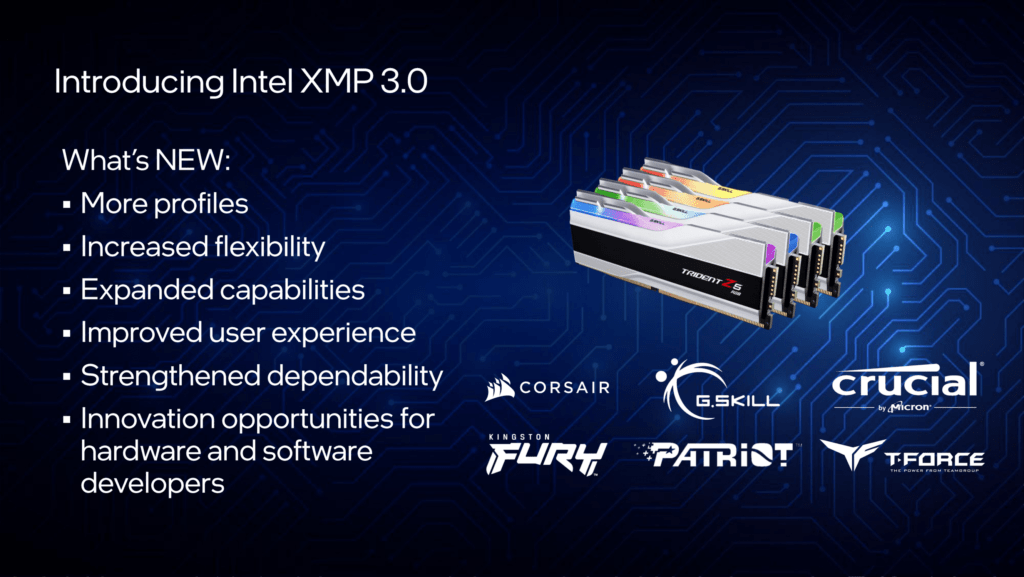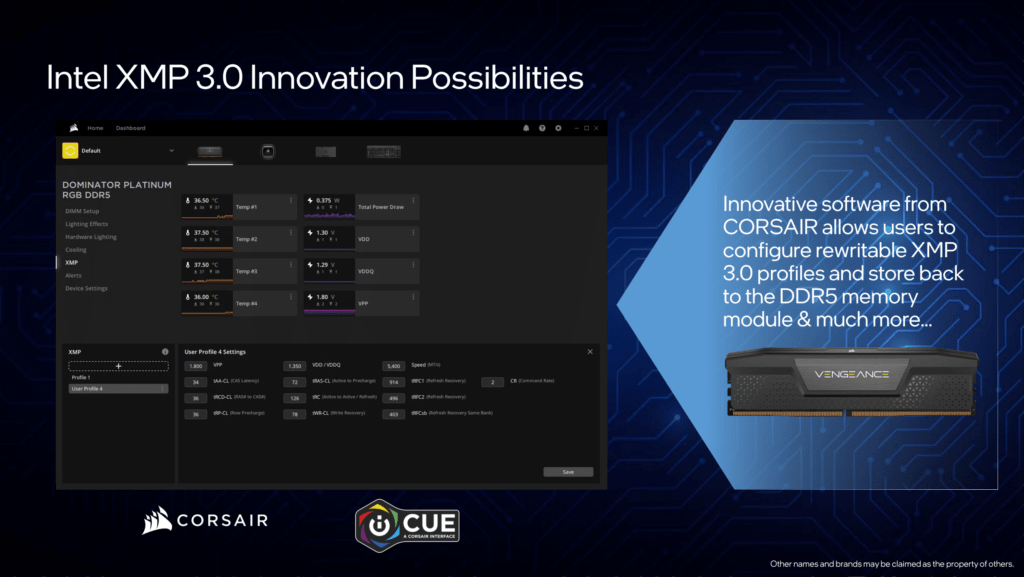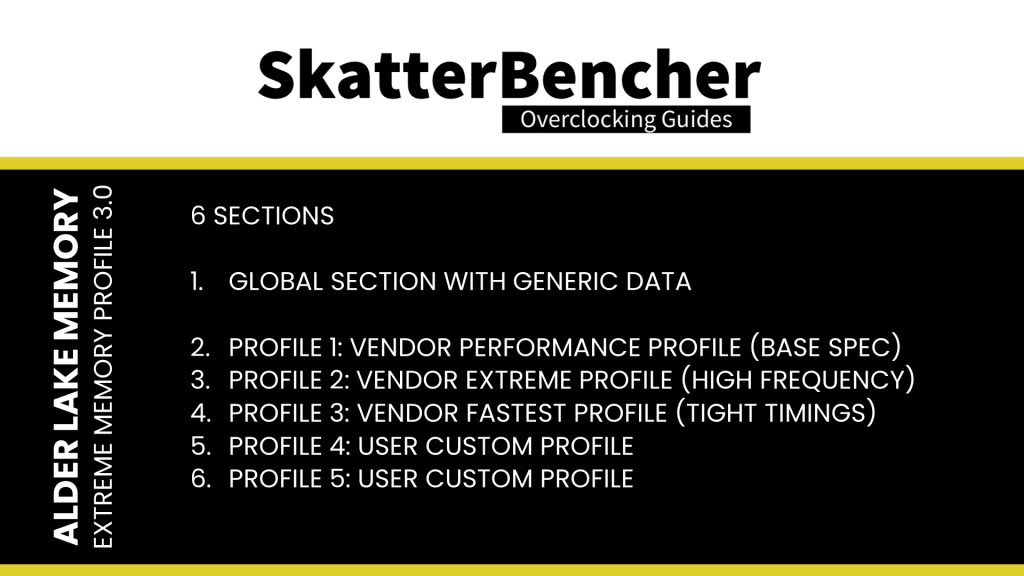Intel Extreme Memory Profile 3.0 is the new XMP standard for DDR5 memory and is the successor to XMP 2.0 for DDR4 memory. It was introduced together with the Alder Lake processors. It is largely based on the XMP 2.0 standard but has additional functionality.




The XMP 3.0 standard is designed with six sections. One global section describes the generic data which is used across the profiles. The other five sections are designed for five profiles respectively.
- Profile 1 is meant for the performance profile (this is the standard XMP as we know it)
- Profile 2 is designed for the extreme settings (this could be a higher frequency at higher voltage)
- Profile 3 is designed for the fastest settings (this could be tighter timings at higher voltage)
- Profiles 4 and 5 are rewritable and meant for user custom settings

The Global Section has only a few configurable fields:
- The XMP ID string
- The XMP version (this will be 3.0 for DDR5)
- The XMP organization (this allows memory vendors to enable or disable Profiles 2 and 3. Profiles 4 and 5 are always enabled)
- The XMP recommended channel configuration (each profile can have a 1 to 4 DIMM per channel recommendation)
- PMIC Vendor ID
- Number of PMICs
- PMIC capabilities
- OC functions available Y/N:
- When set to No, the PMIC supports only the JEDEC specification on frequency and voltage.
- When set to Yes, the PMIC supports additional capabilities of Intel XMP requirements and overclocking capabilities which are out of JEDEC spec. Intel XMP requirements include “programmable” mode and the voltages support higher than 1.435V with 5/10mV switches.
- OC functions enabled Y/N
- This is by default set to enabled when the PMIC supports OC function
- PMIC voltage step size: 5mV or 10mV
Each profile has a wide range of configurable fields related to voltage, frequency, and memory timings, including:
- Module VPP
- Module VDD
- Module VDDQ
- Memory Controller Voltage Level
- tCL
- tRCD
- tRP
- tRAS
- tRC
- tWR
- tRFC1
- tRFC2
- tRFCsb
- Dynamic Memory Boost support
- Real-Time Memory Frequency OC support
- Command Rate
- Vendor ID
The main takeaway from Intel Extreme Memory Profile 3.0 is the following:
- It offers more profiles including 2 which are rewriteable by the user to save custom settings
- It offers extended functions to distinguish between OC and non-OC memory sticks, where non-OC follows JEDEC and OC allows for extended voltage, current, and frequencies.
- The memory profile now includes also a voltage for the CPU memory controller
You can find the official list of self-certified XMP 3.0 memory kits on Intel’s dedicated website.
Extreme Memory Profile 3.0 RDIMM Support
Initially the XMP 3.0 standard was intended for DDR5 UDIMM, just like it’s predecessors. However, alongside the introduction of the Sapphire Rapids platform, Intel also expanded XMP 3.0 with DDR5 RDIMM support.

The difference between DIMM and RDIMM, or Registered Dual In-line Memory Module, is that the latter has a register between the DRAM modules and the system’s memory controller. This buffer reduces the electrical load on the memory controller and thus allows stability with more memory modules.
Intel Extreme Memory Profile 3.0 in SkatterBencher Guides:
- SkatterBencher #68: Intel Core i7-14700K Overclocked to 6200 MHz (link)
- SkatterBencher #67: Intel Core i9-14900K Overclocked to 6200 MHz (link)
- SkatterBencher #59: Intel Xeon w7-2495X Overclocked to 5200 MHz (link)
- SkatterBencher #57: Intel UHD Graphics 770 (13th Gen) Overclocked to 2500 MHz (link)
- SkatterBencher #53: Intel Core i9-13900KS Overclocked to 6300MHz (link)
- SkatterBencher #52: Intel Core i9-13900K P-core Overclocked to 6500MHz (link)
- SkatterBencher #50: Intel Core i7-13700K Overclocked to 6000MHz (link)
- SkatterBencher #49: Intel Core i9-13900K Overclocked to 6100MHz (link)
- SkatterBencher #38: Intel UHD Graphics 730 Overclocked to 1800 MHz (link)
- SkatterBencher #37: Intel Core i5-12400 Overclocked to 5300 MHz (link)
- SkatterBencher #34: Intel Core i9-12900KF Overclocked to 5700 MHz (link)
- SkatterBencher #33: Intel UHD Graphics 770 Overclocked to 2378 MHz (link)
- SkatterBencher #31: Intel Core i7-12700K Overclocked to 5400 MHz (link)
- SkatterBencher #30: Intel Core i9-12900K Overclocked to 5500 MHz (link)